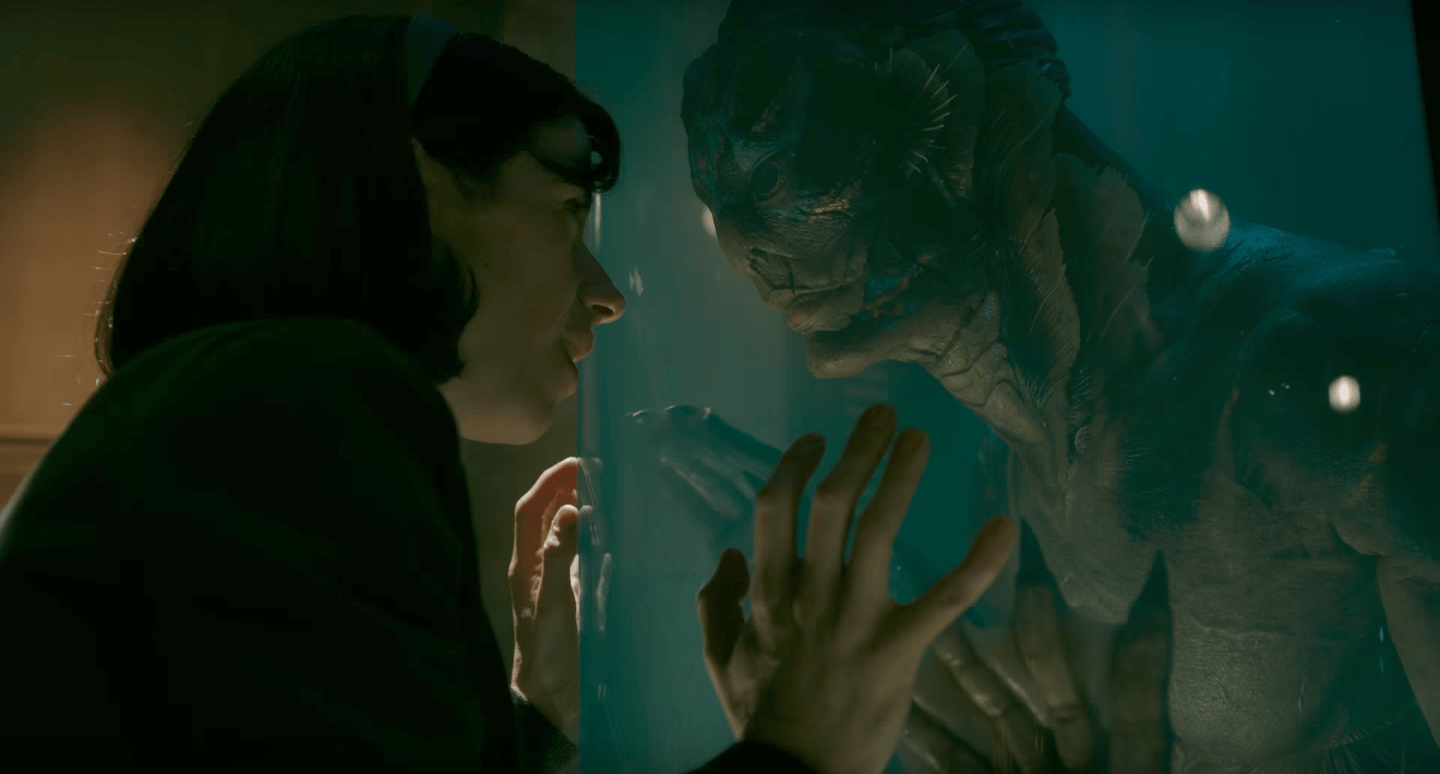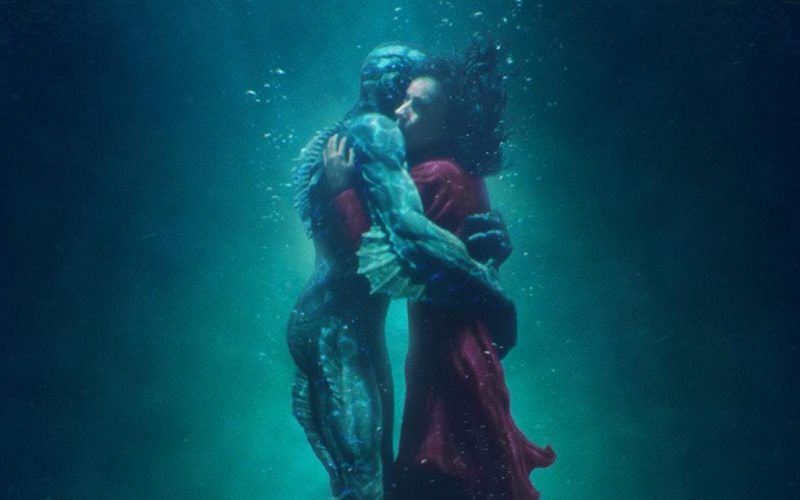The Shape of Water (2017) – Review.
Halfway through The Shape of Water a major event takes place. Eliza, the mute protagonist played exquisitely by Sally Hawkins, has hatched a plan, and she’s now putting it into action. Her friend from work Zelda (Octavia Spencer), brings that plan to a halt, proclaiming it a foolish and dangerous errand. This very literal push and pull evaporates soon enough, and lasts just long enough for a trickle of extra tension to leak into the rather brilliant sequence. And yet it underlines a concerning aspect of the characters in Guillermo del Toro’s latest.
By and large, there are issues here that stem from there seemingly being too much story for the time it’s given. As a result, it’s hard to buy into any of the character motivations and difficult to quite engage or believe in the choices that they’re making. The film centers around Eliza’s budding infatuation with a creature that’s been found in South America, credited as the Amphibian Man (Doug Jones), and her desperate attempt to save it from an ill-deserved fate. Teamed with Zelda and her roommate, Giles (Richard Jenkins), her story unravels early on like a fairy-tale but dovetails into a bizarre romance. The midpoint sequence, an extraction of the creature from its laboratory prison, is one of the film’s best. Prior to that, Eliza’s desperate attempt to convince Giles that her plight was important to her is a warm incision of emotion.
 Unfortunately, the emotion is severely lacking overall. It’s a problematic struggle to latch onto any of the characters, and much of the decisions here just don’t sit well. Characters behave in ways that seem unrealistic, perhaps in keeping with the surreal nature of the film itself; from the set design to the way the entire picture is lit, it offers an intoxicating aesthetic. Nevertheless, Eliza’s desperate need to find someone who doesn’t diminish her because of her infliction only really tugs on one or two occasions. Giles, too, is given a little bit of depth, but seemingly only enough so that he might become devoted to Eliza’s situation. Given that his most meaningful scenes come just prior to this decision, they feel less profound and more of a necessity, a needed element to his character.
Unfortunately, the emotion is severely lacking overall. It’s a problematic struggle to latch onto any of the characters, and much of the decisions here just don’t sit well. Characters behave in ways that seem unrealistic, perhaps in keeping with the surreal nature of the film itself; from the set design to the way the entire picture is lit, it offers an intoxicating aesthetic. Nevertheless, Eliza’s desperate need to find someone who doesn’t diminish her because of her infliction only really tugs on one or two occasions. Giles, too, is given a little bit of depth, but seemingly only enough so that he might become devoted to Eliza’s situation. Given that his most meaningful scenes come just prior to this decision, they feel less profound and more of a necessity, a needed element to his character.
It’s a shame then that, ironically, this element is missing from the characters that surround him. Eliza’s relationship with the creature needs more time than it’s given before she devotes herself to putting her entire life, and the lives of those around her in jeopardy. So too does her falling in love with it suggest something deeply deranged about her that stems from a childhood we only get hints at – something that could have made for more compelling content had it been explored. Instead, del Toro intends for the romance to be front and center, and for it to feel earned and satisfying. It is beautiful, in a sense that the scenes the two characters share offer something visually otherworldly – notably any underwater sequence, in which the world of the film and time in the cinema itself seems to stop in awe of the moment – and yet there’s too many instances in which the film diverts into absurdity and breaks the immersion in the process.
 The world of 1962 is rich and atmospheric. The opening scene sells something different than what the film offers, but its storybook veneer is an alluring hook. There are homages to monster movies of old-aplenty, a kind of love letter to the ‘50s and earlier, recalling films such as Creature from the Black Lagoon, and it’s not tender with its themes; the clearest of all instances being the very dynamic of the relationship between Eliza and her band of marginalized pals and the antagonist Strickland, played with a rather heavy hand (ironic considering the missing fingers) by Michael Shannon. The racist, despicable head of the entire operation, answerable to a general with five Stars on his shoulder, Shannon is not nearly his best here; Jeff Nichols is certainly a director who knows how best to work with his talents, and villainy seems at least here to be a poor fit.
The world of 1962 is rich and atmospheric. The opening scene sells something different than what the film offers, but its storybook veneer is an alluring hook. There are homages to monster movies of old-aplenty, a kind of love letter to the ‘50s and earlier, recalling films such as Creature from the Black Lagoon, and it’s not tender with its themes; the clearest of all instances being the very dynamic of the relationship between Eliza and her band of marginalized pals and the antagonist Strickland, played with a rather heavy hand (ironic considering the missing fingers) by Michael Shannon. The racist, despicable head of the entire operation, answerable to a general with five Stars on his shoulder, Shannon is not nearly his best here; Jeff Nichols is certainly a director who knows how best to work with his talents, and villainy seems at least here to be a poor fit.
The character’s direct conflict with all three characters – a mute, a black woman, and a gay man – is so apparent it need only be said out loud to make it absolute. Add in the creature itself, considered a god before its captivity, and it’s no wonder that Strickland takes joy in torturing the poor beast. Michael Stuhlbarg plays Doctor Robert Hofstetler, a sympathizer with ties to the Russians in a subplot that feels rather necessary given the time period. This is an aspect of the film that isn’t gifted too much time, and del Toro manages to maintain an insular focus; it’s a story about a girl and a monster. It’s as though it was plucked from last century and pulled into this one, dragging with it flashes of film from that century that del Toro slots in where possible.
 The second half of the film breathes too much, starkly contrasting the tone of the first. There’s a fairy-tale trying to be told here and del Toro’s choice of themes are integral to that fairy-tale, but they become so explicit that they’re rid of any depth. Undoubtedly though, del Toro’s film is something rather special. He’s created both a modern monster that’s unique and memorable, with a jaw-dropping design, and a wholly original piece of genre fiction that alleviates some of the drain of studio tent-poles features. And yet there are too many moments demanding me to suspend my disbelief of how human beings behave and it hinges on a relationship I’m simply not given enough reason to believe in.
The second half of the film breathes too much, starkly contrasting the tone of the first. There’s a fairy-tale trying to be told here and del Toro’s choice of themes are integral to that fairy-tale, but they become so explicit that they’re rid of any depth. Undoubtedly though, del Toro’s film is something rather special. He’s created both a modern monster that’s unique and memorable, with a jaw-dropping design, and a wholly original piece of genre fiction that alleviates some of the drain of studio tent-poles features. And yet there are too many moments demanding me to suspend my disbelief of how human beings behave and it hinges on a relationship I’m simply not given enough reason to believe in.
Del Toro’s craft is astonishing. The Shape of Water is mesmerizing from a technical standpoint, a lush canvas of dark green (and teal) hue. It evokes a moody sense of mystery and wonderment for much of its run-time. The script, unfortunately, fails to add the necessary strokes to this canvas for it to make for a truly memorable piece of art.
Film ’89 Verdict – 5/10

